The monkey show continues.
Author: JUGGERNAUT
Translation: DeepTechFlow
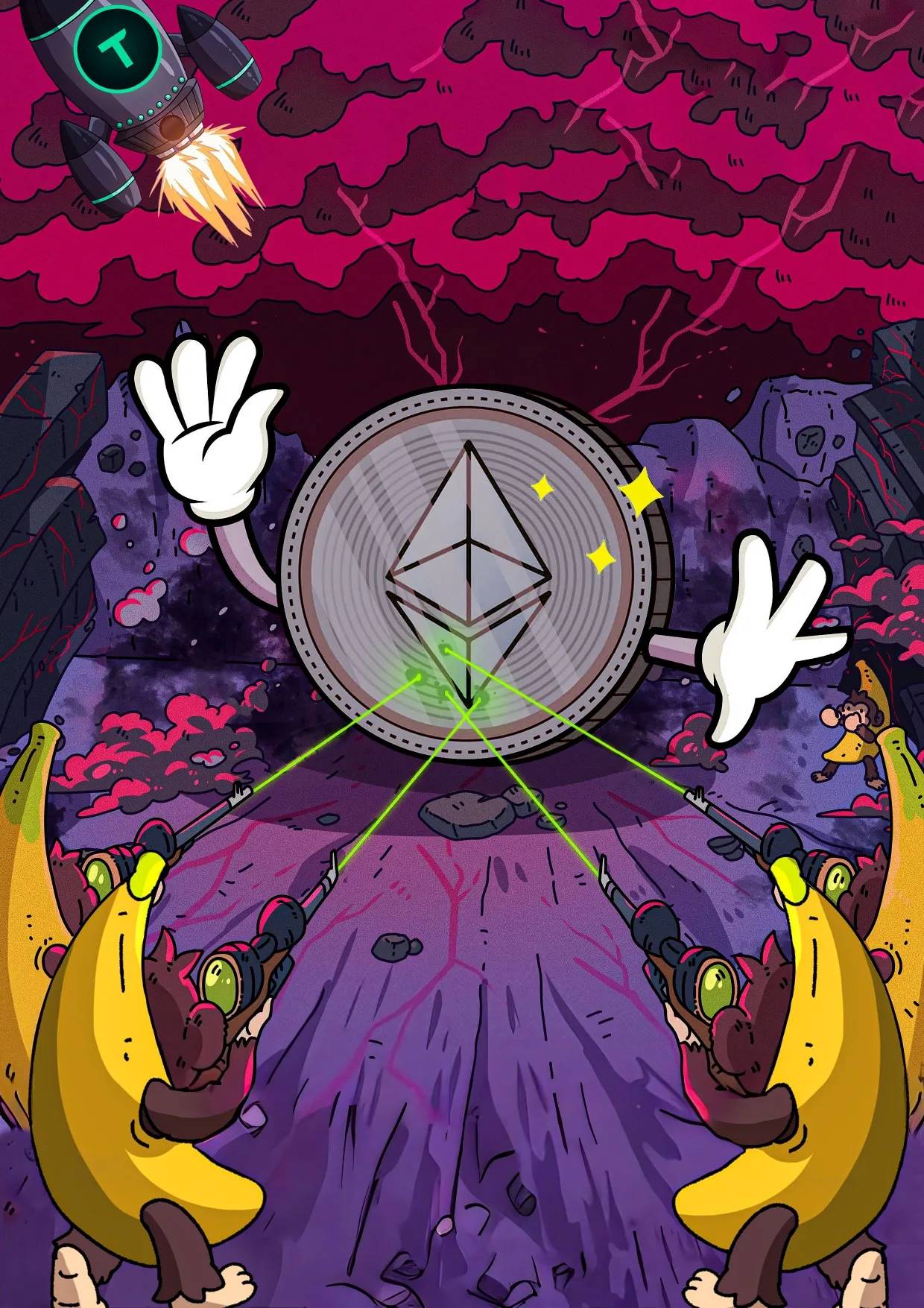
Last year, I published two articles to explore the origins of the Banana Gun Bot team.
These articles analyzed the flow of funds on-chain used to create the Banana Gun Bot and raised some unsettling questions about the background of the developers. When the anonymous background of the leading trading bot developer seems suspicious, the subsequent question is, for whose benefit does the Banana Gun Bot operate?
In the micro-market, 10 months is a long time. In fact, in the entire decentralized finance (DeFi) field, it is also a long time. I sat down to review how correct (or incorrect) my view of the Banana team was. I found the issues to be much deeper than I had initially imagined—and raised serious questions about the future operation of Ethereum.
To set the stage, let's look at some data.
Since May 2023, TG Bot has been widely accepted in the DeFi ecosystem, becoming a stable business model and making significant contributions to daily on-chain transaction volume. In the past year, TG Bot's trading volume accounted for 20% - 30% of the total Ethereum transaction volume, calculated as a percentage of the number of transactions. As of June 2024, all TG Bot trading volumes accounted for 9.4% of Ethereum transaction volume and came from nearly 5.3% of Ethereum wallets. Therefore, TG Bots like Banana have become important trading initiators on Ethereum and play a significant role in the Ethereum ecosystem.
Since June 2023, at least $5.25 billion in capital has flowed through the Banana Gun router. Although some of it is on Solana, this makes Banana second only to Maestro (the first participant in the field, leading competitors by over a year) and Bonk Bot (seen by some as a bet on the entire SOL junk coin ecosystem).
Observers are puzzled by the speed at which Banana captures market share. The main reason for establishing this overwhelming dominance is the success rate of Banana Gun Bot's sniper bundling. In its early days, Banana became the preferred bot for users who wanted to snipe rather than just trade. In the world of junk coins with a typical trading lifecycle of only a few hours, being first in at "block 0" is often the only important thing.
Simply put, the "block 0" of a token refers to the block where the token "opens for trading" at launch, and sniping a token at launch means your buy transaction needs to be executed immediately after the token developer's "open for trading" transaction. To achieve this, since its launch in late May 2023, Banana Gun has suppressed all competitors by "bundling" user bribes. These bundled transactions are more profitable for Ethereum developers as they enhance and aggregate the fees paid to developers.
Banana Gun's strategy has been so effective that from June 2023 to October 2023, compared to the industry-leading TG Bot "Maestro" (operating since mid-2022), Banana Gun users' dominance at "block 0" increased from 7% to winning 88% of the first batch of bundled transactions in the TG Bot field.
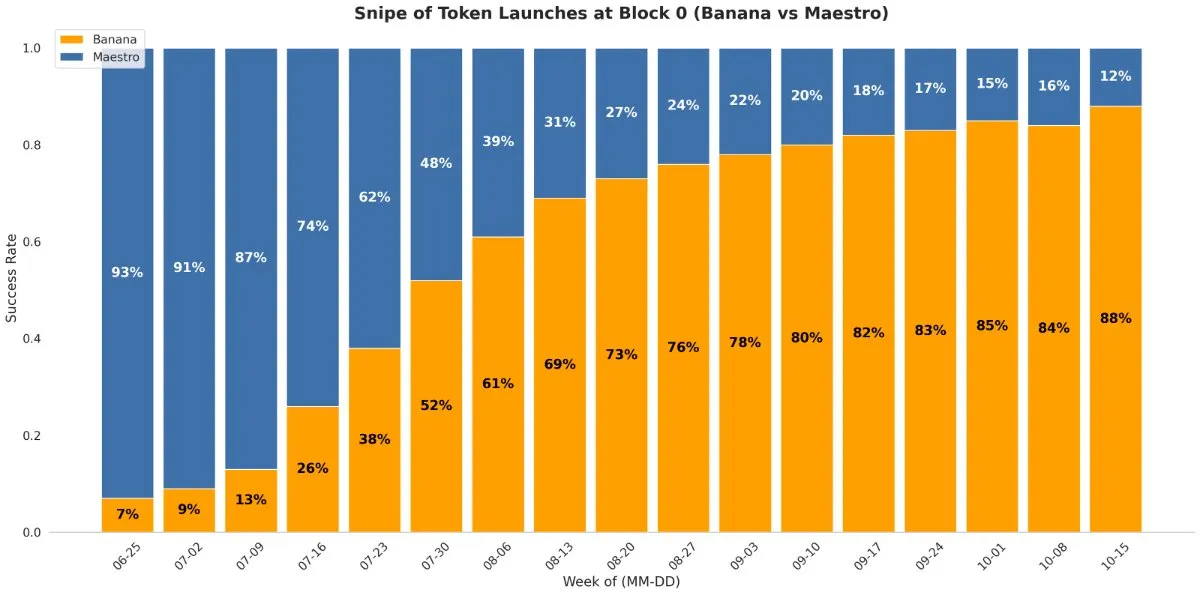
Source: The Scientific Crypto Investor and Duncan | Flood Capital
A new market reality is emerging—where ordinary junk coin investors are doomed to fail by choosing Banana's competitors. If you want to get in first, you have to join a Banana "block 0" bundle. A culture of paying high bribes has gradually formed among Banana user groups, initially mocked on crypto Twitter but quickly accepted as a fait accompli.
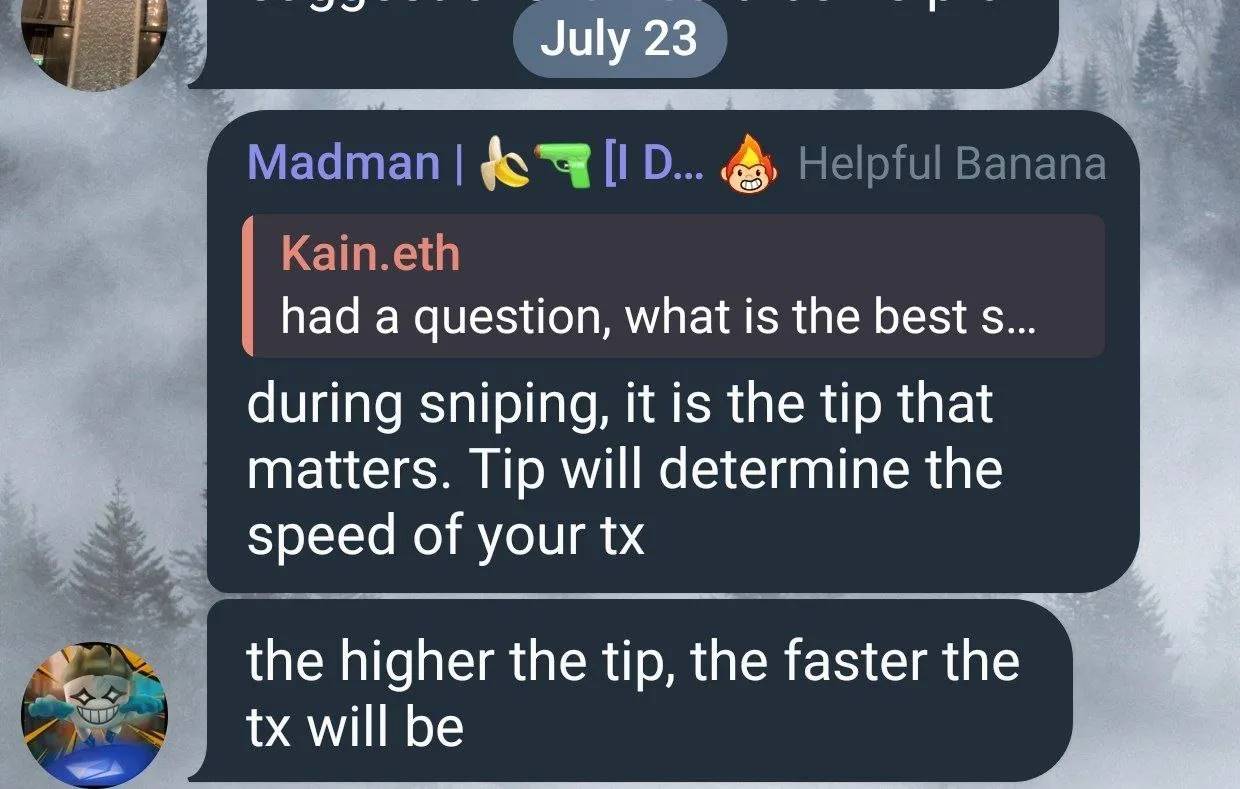
Source: Banana Gun TG
In fact, the high bribery culture of Banana users is seen as a sign of their business success and is considered a value indicator for $BANANA token holders. One characteristic of Banana's bribery culture is that even in bundled transactions, it is a player-versus-player (PvP) competition, with well-funded users entering the token first, while small bribe givers provide liquidity for leading Banana users to exit.
The Banana team itself acknowledges that the bot was initially created for a small circle of "friends," but was later opened to the public because its development team was evidently fervent decentralization communists.
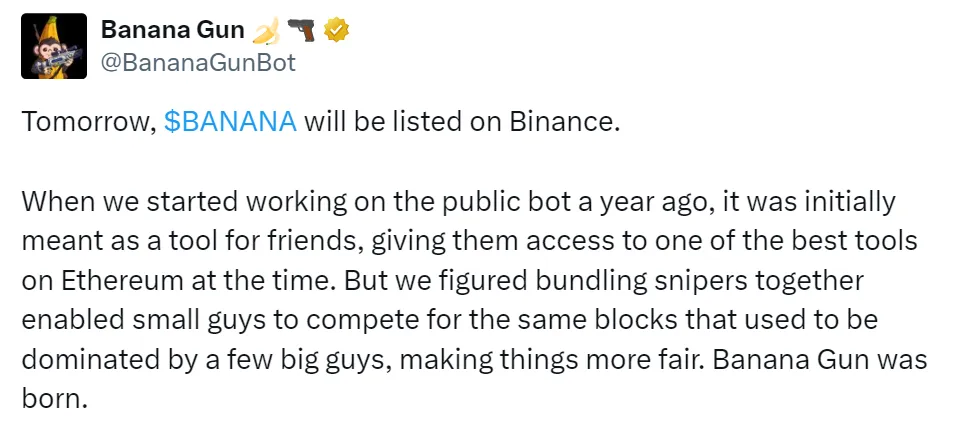
Source: Banana Gun X Handle
It is worth noting that the accusations about the Banana team preemptively trading by monitoring user bribes remain unclarified to this day. In any case, the second aspect of Banana Gun Bot's dominance in bundled transactions is beginning to evolve into a case study for the entire Ethereum ecosystem.
Separation of proposers and builders
When dominance becomes the status quo
In September 2023, the Banana Gun Bot team launched the $BANANA token, promising to share 40% of the income generated by the bot with users. By November 2023, Banana Gun Bot had already captured over 90% of all block 0 snipes, far ahead in adoption and income generation compared to its competitors. According to sources, in December 2023, the Banana team executed a brilliant strategy. In ETH junk coin trading, Banana cleverly turned its early lead in the TG Bot market into an economic moat against competitors by normalizing the high bribery culture and leveraging its dominance at block 0, exploiting a long-theorized but unrealized systemic weakness of the Ethereum system.
Understanding this process requires a basic understanding of how Ethereum operates after the merge—especially the concept of "Proposer Builder Separation" (PBS). For ordinary people like me who don't understand but want to learn about the concept behind PBS, I have a separate note that can be found here.
In a healthy competitive block-building market based on proposer allocation (PBS), transactions initiated by TG Bot are typically allocated to various builders, who retrieve pending transactions from the transaction memory pool, optimize them for maximum value, build blocks, and bid them to proposers to ensure their own blocks are included. The real-time visualization of this transaction process within the 12-second lifecycle of a block can be seen on Payload.
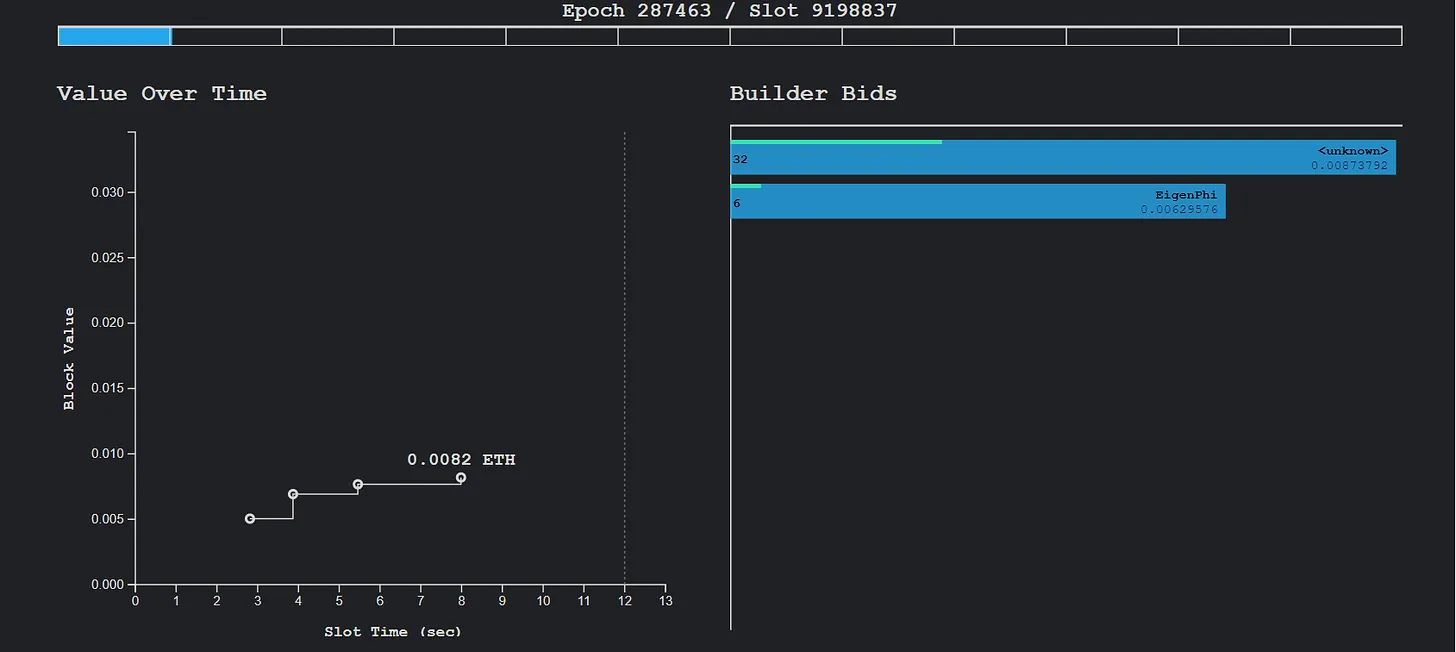
Ideally, in an open competitive bidding process, proposers gain the highest fees by selecting the best bid from competing builders. Therefore, value is redistributed back into the Ethereum ecosystem (as proposers stake ETH and secure the Ethereum chain), while builders also receive rewards in a competitive manner (as they transfer most of the transaction fees to proposers).
The issue is that the competitive nature of the block-building market may be constrained by various factors. Last year, the Special Mechanism Group (SMG) pointed out in their paper "Concentration Effects" (Gupta et al., 2023) that over time, a small group of savvy builders will naturally dominate PBS. Interestingly, they proposed in May 2023 that this concentration trend is mainly due to "block top" opportunities, such as CEX-DEX arbitrage.
"Block top" refers to the first few transactions executed in each block. CEX-DEX arbitrage refers to professional traders exploiting price differences between tokens on centralized exchanges (such as Binance) and decentralized exchanges (such as Uniswap). SMG mentioned that the advantage of block top opportunities in PBS is mainly monopolized by builders rumored to be associated with high-frequency trading (HFT) companies, such as Manta, Rsync Builder, and Beaver Build. In comparison, the SMG team also analyzed Blocknative, Builder69, and Flashbots as other high-volume but non-HFT builders, thus validating their assumptions. Ironically, SMG mentioned in a paper in June 2023 that Titan Builder received more order flow, leading to their dominance in PBS auctions.
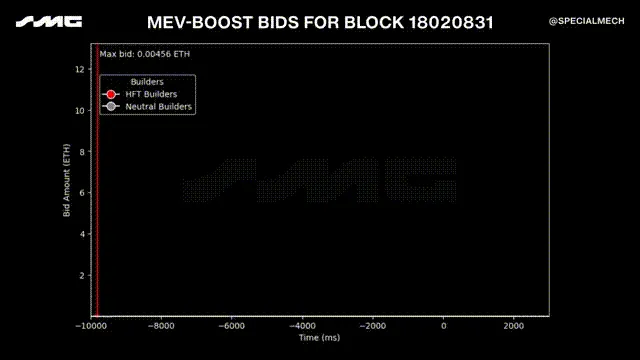
Visualization of PBS advantage supported by HFT funds
An important conclusion drawn by SMG is that "builders who receive more income from block top are more willing to pay more for private order flow, as they need to win the entire block to leverage their block top advantage." Therefore, SMG envisions a scenario where savvy builders, funded by HFT companies, may monopolize PBS if they receive private order flow to consolidate their leading position. This would suppress smaller builders—as pondered by Titan Builder in their paper in June 2023 (the young Titan's public RPC only went live on April 17, 2023).
So, what is private order flow?
The rebellious rise of junk coins in 2020 created a systemic problem for Ethereum— "MEV." Over the past 3 years, transaction senders have become increasingly unwilling to send transactions to the public Ethereum pending transaction pool and have turned to private pending transaction pools to avoid being front-run by MEV bots. To some extent, private pending transaction pools provide protection for transaction senders, thus constituting a public interest. TG Bot's transactions are seen as high-quality transactions for MEV bot operators, as its users are typically advised to set high slippage to ensure their transactions succeed in highly volatile tokens.
To guard against this possibility, almost 97% of TG Bot transactions are conducted through these private pending transaction pools. However, this is not the type of transaction that SMG was referring to when concerned about HFT companies monopolizing the PBS system. The "private order flow" mentioned by SMG refers to order flow from a single transaction sender, specifically sent to a single builder.
Firstly, TG Bot offers not only sniping services but also regular buy and sell transactions, including on-chain limit orders. However, Banana's business model is primarily rooted in its "sniping" narrative. Its high block 0 bribery culture drives its strong revenue stream. Therefore, Banana's business model is based on the guarantee to users that they will enter token trading before any competitors. Typically, to maximize the chances of successful on-chain block 0 bribery bundling, such proposers will send their bundles to all leading builders on Ethereum.
For example, suppose you and I, as Ethereum builders, receive the same 10 ETH bundle from TG Bot, including a 5 ETH "tip" to incentivize the bundle to be prioritized over all other bundles in a block. I build a potential block, and you also build one. I bid 1 ETH, you see that and bid 1.1 ETH, and so on until the entire 5 ETH is exhausted. In this scenario, ultimately, this 5 ETH will be sent to the proposer, rather than being pocketed by a builder.
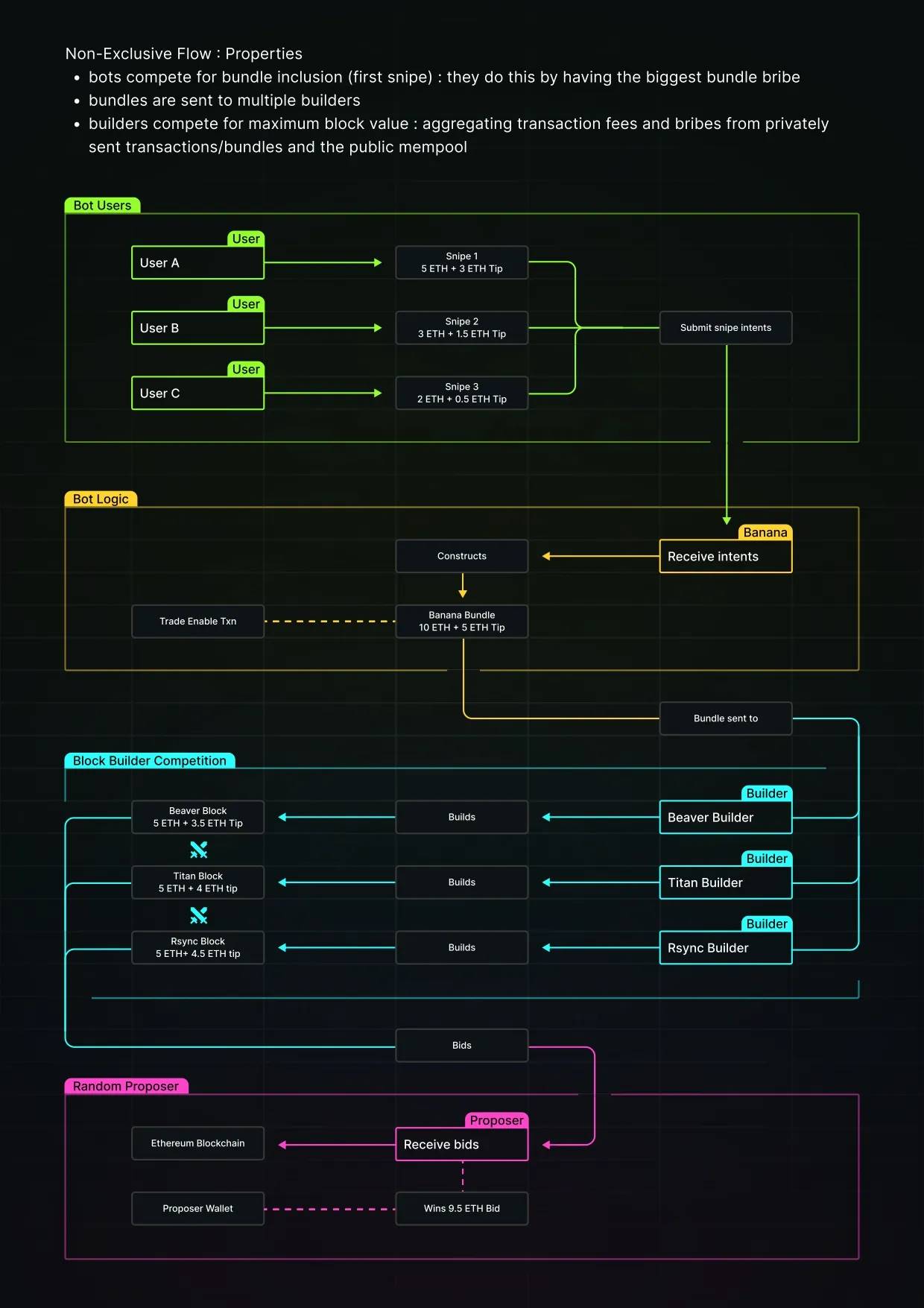
Note: This example assumes no other TX sent to the builder
Logically, when TG Bot sends its bundles to multiple builders, it maximizes the chances of the bundle being included in a winning block and on-chain, as builders compete with each other to ensure their blocks are accepted by validators. On the other hand, sending exclusive order flow (EOF) to a single builder means that the builder must successfully include the order flow (and the bribe) on-chain. Any delay would weaken this advantage—the bundle would no longer be a snipe. Therefore, ideal proposers like Banana should at least offer the order flow to builders with the highest inclusion rate on-chain. Based on SMG's research at the launch of Banana, it is evident that builders like BeaverBuild, supported by well-funded HFT companies, would be the ideal recipients of EOF for Banana. But as we will see next, the Banana team chose a different path.
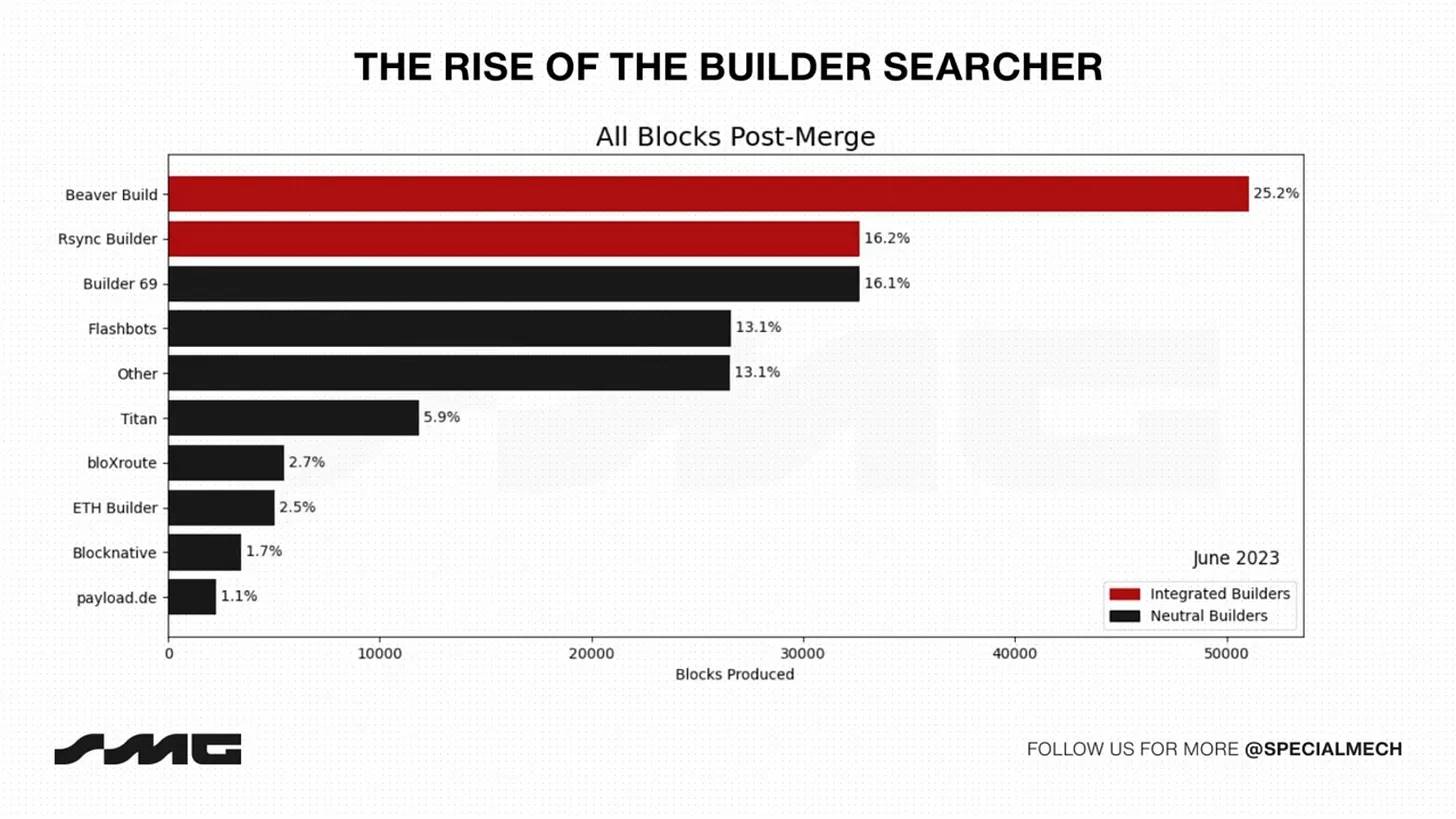
As of June 2023 PBS market. Source: SMG
An indirect consequence of specifically providing Banana order flow to a particular builder may be as follows.
When a high-bribe bundle is specifically sent to a particular builder, other builders cannot access that bundle and therefore cannot receive its bribe. The rational strategy for the "chosen" builder is to gradually increase the bid to ensure that the bundle is included in the next block with the least amount paid to the proposer. Therefore, if a block 0 bundle with a 5 ETH bribe is routed through EOF, and at that time the highest block bid from competing builders is 1 ETH, the exclusive builder can bid "just enough" to ensure the block (e.g., 1.1 ETH), and keep the remaining 3.9 ETH as pure profit.
What does the Banana team gain from providing EOF to a single builder? The answer lies in the potential kickback of profits brought by that builder. This EOF agreement means that the builder can return part of the bribe to Banana (as payment for EOF), so now Banana profits not only from transaction fees but also from the high-bribe culture among its users. This is not a novel business model—Robinhood Markets in the United States has been paid hundreds of millions of dollars by Citadel for "order flow payments."
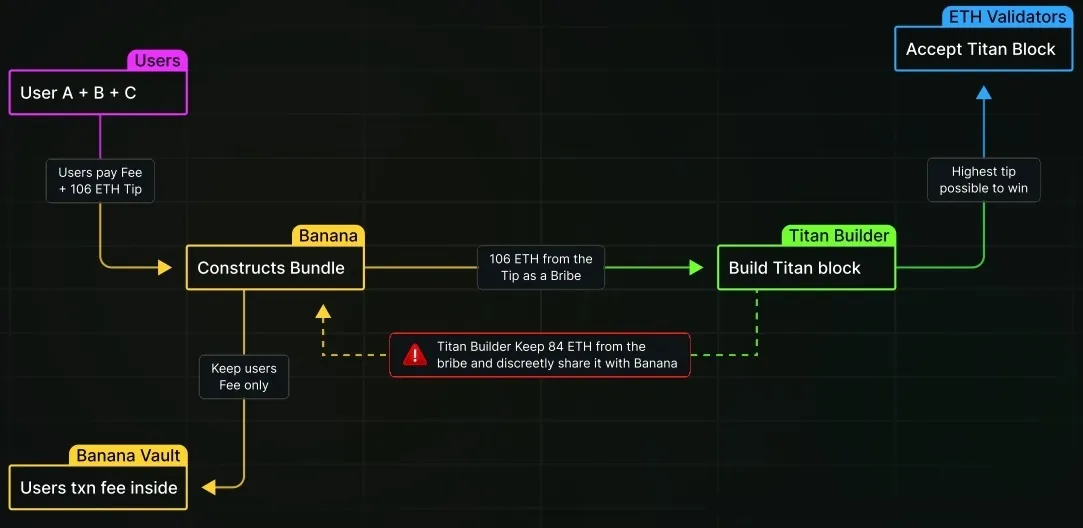
Source: Ethereum Block 19238546
Q: Has the Banana team publicly acknowledged the existence of such EOF agreements?
A: No.
Q: As the issuer of the $BANANA token and custodian of the project treasury, does the Banana team redistribute overpaid bribes to its users or $BANANA token holders?
A: Absolutely not.
Q: But more importantly, in 2023, did the Banana team execute EOF agreements with the highest market share Ethereum builders in block construction to ensure the best chance of its users' bribed block 0 bundles being included on-chain in good faith?
A: Strangely, no.
'Behind-the-scenes deals in the dark forest'
Analysis of Banana Gun router transactions shows that the Banana team primarily routes its snipe bundles through Titan Builder most of the time.
In April 2023, Titan had only a 1% market share in the PBS block construction market. When the Banana team began directing exclusive order flow (EOF) to Titan, Titan's performance in the PBS market lagged far behind other builders. It is worth noting that in the 7 days prior to the publication of this article, Titan had contributed nearly 40% of all Ethereum blocks.
In less than a year, Titan has become:
The second-largest builder on Ethereum, and
The most profitable builder in the Ethereum PBS ecosystem, largely due to the EOF support from the Banana Gun team.
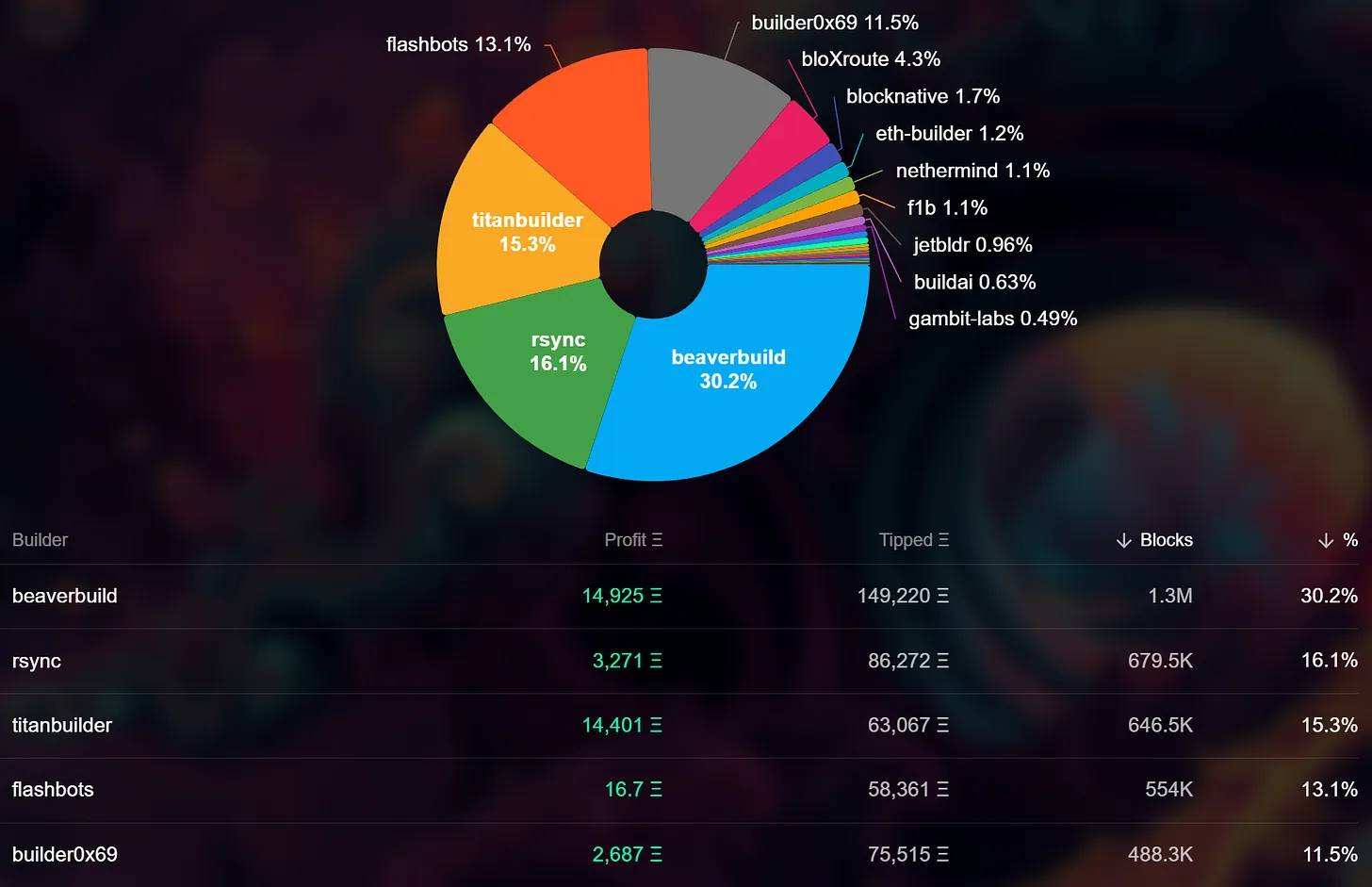
Source: libMEV
A closer look at the data in the graph above from libMEV reveals the true scale of Titan's success.
Beaverbuild is the leading block builder in the post-merge Ethereum PBS. Since the merge, it has constructed over 1.2 million blocks, resulting in 146,241 ETH in earnings for Ethereum validators and generating a profit of 14,520 ETH for Beaverbuild.
As an example, Flashbots builders have delivered over 552,800 blocks, earning a profit of 16.7 ETH, while transferring 58,349 ETH to the Ethereum ecosystem through their validator fees. On the other hand, since May 2023, Titan has delivered 615,200 blocks, earning a profit of 13,151 ETH, while transferring 60,912 ETH to the Ethereum ecosystem.
In doing so, Titan's profit is nearly 787 times that of Flashbots builders, while delivering slightly more blocks than Flashbots. Similarly, although Beaverbuild retains about 9% of the ETH paid by users for building blocks, Titan has earned 17.75% of the ETH as its own profit, with less than half the number of blocks built by Beaverbuild!
A recent excellent paper by Markovich (May 2024) delves into this arrangement. She uses Block 19728051 (referred to as Block 8930981 in the paper) as an example, with a total value of 76.38 ETH, a total priority fee of 4.54 ETH, and a total bribe paid to Titan of 72 ETH.
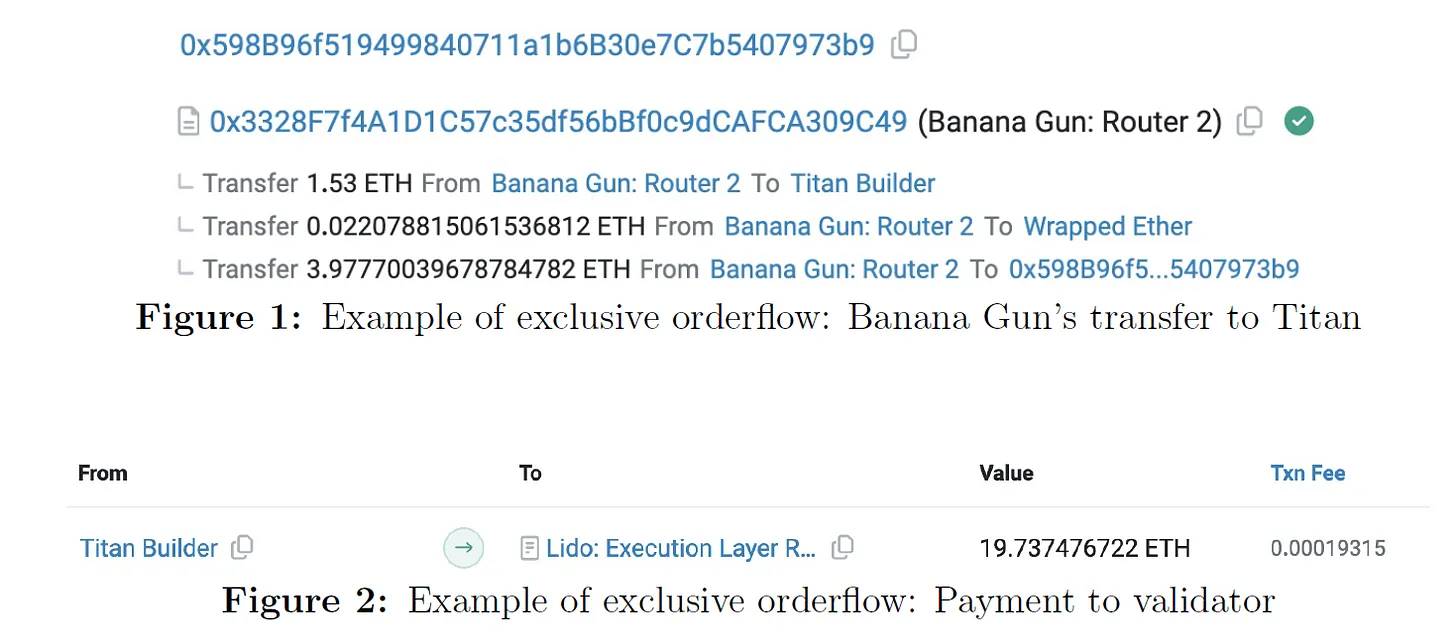
Source: "Decentralized Monopoly Power in DeFi", Sarit Markovich
Sarit points out that in Block 19728051, proposer Lido was only able to earn 19.75 ETH from the block, while Titan gained a pure profit of 56.6 ETH through the EOF agreement with the Banana Gun team.
Sarit analyzed 181,651 blocks between April 6, 2024, and May 5, 2024. She also studied Banana and Maestro, but the latter's team is not relevant for this article as it does not have a token and does not promise any benefits or profits to token holders in its ecosystem. Sarit reports that in her dataset, the total block value was 21,406 ETH, of which only 17,127 ETH was transferred to the Ethereum ecosystem through its proposers. Therefore, proposers lost 4,279 ETH in this short period. Specifically, Lido did not receive 1,666 ETH in payment in this dataset for a single month.
This paper supports my preliminary calculations when reviewing over 3500 blocks on the Ethereum chain between December 2023 and March 2024, during which Banana block 0 bundles were almost exclusively routed through the Titan Builder. This indicates that out of the total 4466.89 ETH paid by Banana users to have their snipe transactions included on-chain, only 2915.65 ETH was transferred to Ethereum proposers, while 2271.26 ETH was captured by Titan Builder. Even assuming a 50-50 split of private EOF between Banana and Titan, it can be inferred that during this period, 1135.63 ETH was sent back to the private account of the Banana Gun team. These would be undisclosed profits, amounting to millions of dollars, from innocent users guided into a high-bribe culture by the Banana Gun team.
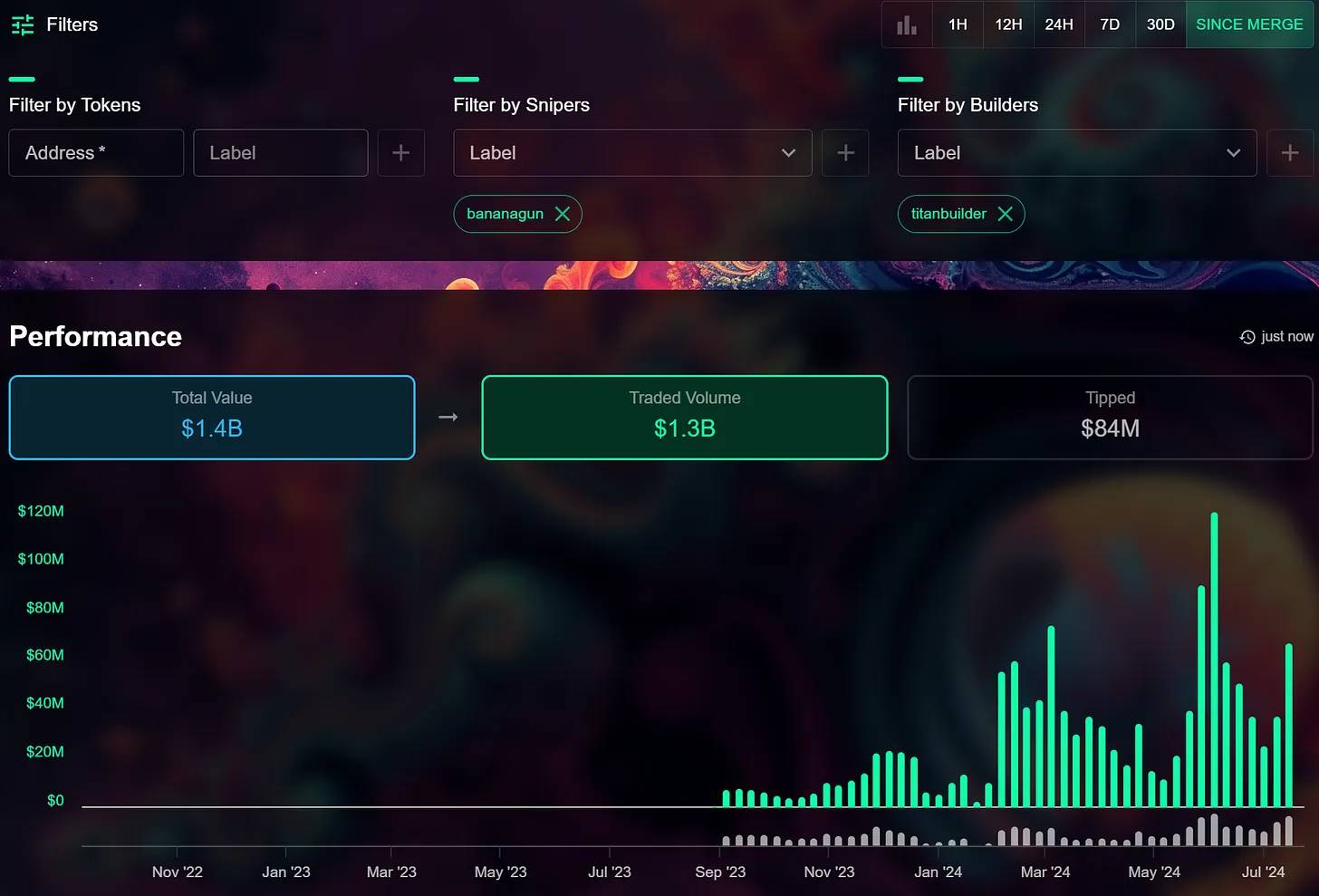
Source: libMEV
Conclusion
An undisclosed team with suspicious background,
Suspected of monitoring user transactions to front-run trades (using it as their own exit liquidity),
Extracting millions from an apparent exclusive order flow arrangement instead of paying it to Ethereum validators or distributing it to $BANANA holders,
Creating a concerning centralization effect, putting pressure on the entire operation of the Ethereum PBS system,
Furthermore, the $BANANA token is listed on Binance, giving their brand significant legitimacy in the public eye.
Therefore, the monkey business continues.

免责声明:本文章仅代表作者个人观点,不代表本平台的立场和观点。本文章仅供信息分享,不构成对任何人的任何投资建议。用户与作者之间的任何争议,与本平台无关。如网页中刊载的文章或图片涉及侵权,请提供相关的权利证明和身份证明发送邮件到support@aicoin.com,本平台相关工作人员将会进行核查。




